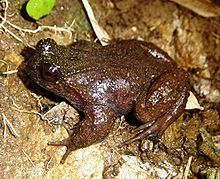| Insuetophrynus | |
|---|---|

| |
| Scientific classification | |
| Domain: | Eukaryota |
| Kingdom: | Animalia |
| Phylum: | Chordata |
| Class: | Amphibia |
| Order: | Anura |
| Family: | Rhinodermatidae |
| Genus: | Insuetophrynus Barrio, 1970 |
| Species: | I. acarpicus
|
| Binomial name | |
| Insuetophrynus acarpicus Barrio, 1970
| |
Insuetophrynus is a monotypic genus of frogs in the family Rhinodermatidae.[2] The sole species is Insuetophrynus acarpicus, also known as Barrio's frog.[3] It is endemic to Chile and only known from few localities on the Valdivian Coast Range between Chanchán in the Los Ríos Region in the south and Queule (southernmost Araucanía Region) and Colequal Alto in the north; the fourth locality is Mehuín, which is the type locality. The altitudinal range is 50–486 m (164–1,594 ft) asl.[3][4]
Description
[edit]Adult males measure 41–56 mm (1.6–2.2 in) and females 35–53 mm (1.4–2.1 in) in snout–vent length.[5] The body is sturdy with muscular arms and legs (these frogs are powerful jumpers). The toes are partially webbed and thinner than the fingers which are short, thick, and unwebbed. The head is wider than long, with a broad, rounded snout. The eyes are large, and tympanum is visible but not large. The back is reddish brown with some whitish granulations. The hind legs have transverse, darker bands. The throat is pinkish yellow, and the stomach is pale. Skin is dorsally quite granular or warty. Also ventral region is also very granular, apart from the throat that is fairly smooth.[6]
Habitat and conservation
[edit]Insuetophrynus acarpicus inhabits coastal streams in temperate forest. Adults hide under stones during the day, emerging at night to feed along the stream margins. Tadpoles can be found under stones in muddy areas with slow current.[1][4]
The species has a small area of distribution (its known range extends only 33 km along the coast[4]) and its habitat is threatened by clear cutting and afforestation.[1]
References
[edit]- ^ a b c IUCN SSC Amphibian Specialist Group (2018). "Insuetophrynus acarpicus". IUCN Red List of Threatened Species. 2018: e.T10832A79809262. doi:10.2305/IUCN.UK.2018-1.RLTS.T10832A79809262.en. Retrieved 16 November 2021.
- ^ Frost, Darrel R. (2015). "Insuetophrynus Barrio, 1970". Amphibian Species of the World: an Online Reference. Version 6.0. American Museum of Natural History. Retrieved 1 November 2015.
- ^ a b Frost, Darrel R. (2015). "Insuetophrynus acarpicus Barrio, 1970". Amphibian Species of the World: an Online Reference. Version 6.0. American Museum of Natural History. Retrieved 1 November 2015.
- ^ a b c Rabanal, F. E.; Nuñez, J. J. (2012). "Discovery of a new population of the Critically Endangered frog Insuetophrynus acarpicus Barrio, 1970 (Anura: Cycloramphidae): Latitudinal and altitudinal extension in the Valdivian Coastal Range, southern Chile". Check List. 8 (4): 810–812. doi:10.15560/8.4.810.
- ^ Diaz, Nelson F.; Valencia, Jose; Sallaberry, Michel (1983). "Life history and phylogenetic relationships of Insuetophrynus acarpicus (Anura: Leptodactylidae)". Copeia. 1983 (1): 30–37. doi:10.2307/1444695. JSTOR 1444695.
- ^ "Barrio's Frog (Insuetophrynus acarpicus)". EDGE of Existence programme (Evolutionarily Distinct and Globally Endangered species). Zoological Society of London. Retrieved 1 November 2015.
[[Category:Amphibians ]]
